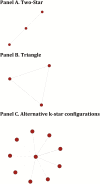A scoping review of patient-sharing network studies using administrative data
- PMID: 30016521
- PMCID: PMC6086089
- DOI: 10.1093/tbm/ibx015
A scoping review of patient-sharing network studies using administrative data
Abstract
There is a robust literature examining social networks and health, which draws on the network traditions in sociology and statistics. However, the application of social network approaches to understand the organization of health care is less well understood. The objective of this work was to examine approaches to conceptualizing, measuring, and analyzing provider patient-sharing networks. These networks are constructed using administrative data in which pairs of physicians are considered connected if they both deliver care to the same patient. A scoping review of English language peer-reviewed articles in PubMed and Embase was conducted from inception to June 2017. Two reviewers evaluated article eligibility based upon inclusion criteria and abstracted relevant data into a database. The literature search identified 10,855 titles, of which 63 full-text articles were examined. Nine additional papers identified by reviewing article references and authors were examined. Of the 49 papers that met criteria for study inclusion, 39 used a cross-sectional study design, 6 used a cohort design, and 4 were longitudinal. We found that studies most commonly theorized that networks reflected aspects of collaboration or coordination. Less commonly, studies drew on the strength of weak ties or diffusion of innovation frameworks. A total of 180 social network measures were used to describe the networks of individual providers, provider pairs and triads, the network as a whole, and patients. The literature on patient-sharing relationships between providers is marked by a diversity of measures and approaches. We highlight key considerations in network identification including the definition of network ties, setting geographic boundaries, and identifying clusters of providers, and discuss gaps for future study.
Figures



Comment in
-
The nature and scope of patient-sharing network research: a novel, important area for network science.Transl Behav Med. 2018 Jul 17;8(4):626-628. doi: 10.1093/tbm/iby052. Transl Behav Med. 2018. PMID: 30016522 Free PMC article.
References
-
- Southwell BG. Social Networks and Popular Understanding of Science and Health: Sharing Disparities. Baltimore, MD: JHU Press; 2013.
-
- Tankard ME, Paluck EL. Norm perception as a vehicle for social change. Soc Issues Policy Rev. 2016;10(1):181–211.
-
- Southwell BG, Slater JS, Rothman AJ, Friedenberg LM, Allison TR, Nelson CL. The availability of community ties predicts likelihood of peer referral for mammography: Geographic constraints on viral marketing. Soc Sci Med. 2010;71(9):1627–1635. - PubMed
-
- Luke DA, Harris JK. Network analysis in public health: History, methods, and applications. Annu Rev Public Health. 2007;28:69–93. - PubMed
Publication types
MeSH terms
Grants and funding
LinkOut - more resources
Full Text Sources
Other Literature Sources
Medical
Miscellaneous

